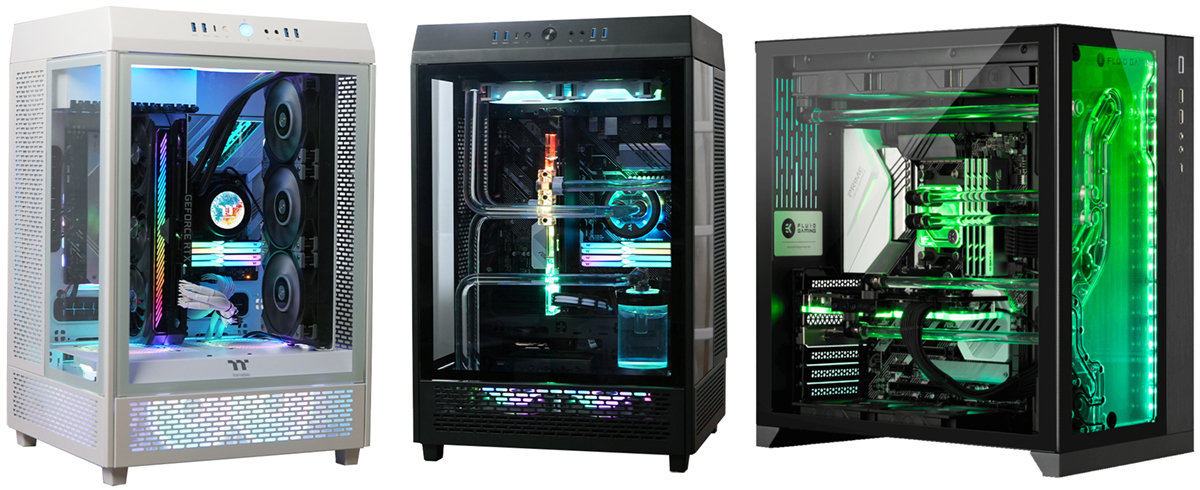People building larger, more robust computers today often have to address the higher levels of heat in the computer. One of the major concerns is the CPU and how much heat it generates. This can be affected by multiple factors including the CPU speed, overclocking, case airflow, and even other high-heat devices in the case.
A common question for today’s computers is what is better for your setup: Air or Liquid coolers? Let’s look at what the differences are.
Air Coolers
Air coolers are the type of cooler that usually comes with a CPU when you buy them. They are a metal unit that transfers the heat from the CPU into fins that fans then blow across to cool, thus dissipating the heat. Air coolers are usually bulkier in size, especially when you get to the larger units that are needed to cool the faster, more powerful processors. Air coolers usually are less expensive than liquid coolers, and come in different sizes, but they can be too large to fit in some smaller cases.

An example of common CPU Air Coolers
Liquid Coolers
Liquid coolers are similar to the radiator system in a car. They use liquid that goes in the CPU block to transfer the heat from the CPU to the liquid. Then the liquid is pumped into a radiator system where the liquid going thru the fins of the radiator are cooled by fans attached to it, thus removing the heat from the CPU via the liquid.
Liquid coolers can be of an AIO (All-In One or Closed Loop) type cooler, or a Custom Loop cooling system. AIO coolers are usually a sealed unit that has the CPU Block, pump, hoses and radiator system already filled with liquid and ready for you to mount in your case. A custom loop system is where you have to purchase the different parts of your liquid cooling system, assemble it (without leaks) and fill your system’s liquid yourself. Custom loop systems are much more complicated to setup, but offer some unique designs in their implementation.

An example of CPU Liquid Coolers - AIO & Custom Loop
Considerations for cooler type
Heat generated by the CPU/GPU
A common indicator for the heat expected of a CPU is the TDP rating. TDP stands for thermal design power – maximum heat a component can use (in Watts). The higher the TDP, the more power it consumes, and the more heat it generates. Make sure your cooler is rated high enough to cool the CPU/GPU sufficiently.
Size of cooler/mounting space
Depending on your computer case, the space available for the cooler to mount can be limited. This can eliminate some coolers due to their size/mounting system. Smaller cases can quickly eliminate large air coolers and large liquid coolers just because there is no room for them.
Style / Aesthetics
Liquid coolers in general give more options for the aesthetics of your system. In many AIO or custom loop cooling systems, there are options for a more colorful setup. Most larger air coolers are bulky and can obscure your aesthetics, even if they have RGB options on them.
Price
Air coolers are generally less expensive than liquid coolers. With both air coolers and liquid coolers, larger coolers that are needed for higher TDP CPUs are more expensive. Also, more aesthetically pleasing coolers are usually more expensive as well.
Maintenance
Keeping your cooler working correctly is important. With air coolers and AIO liquid coolers, this usually means just cleaning the radiator fins and the fans of dust buildup. However, with both AIO and custom liquid coolers, over time liquid breaks down back into a gas, and your liquid levels can drop, thus affecting the cooling performance of your liquid cooler. An AIO liquid cooler usually does NOT have a way to fill the liquid levels.
Taking all this into account, the AIO coolers usually have the shortest life span, on average around 5 years before needing to be replaced.
So, what is the best option for you?
As you can see, there are lots of things to consider in deciding what cooler is best for your build. Need some help? Ask one of our knowledgeable technicians! Our friendly staff will gladly assist you in finding the right fit for your needs and budget.